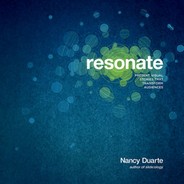172 Resonate
The old adage is true: You never get a second chance
to make a first impression. But is telling a joke or using
a cheesy icebreaker really the way to start?
Make some creative choices before the presentation
begins. What is the first thing you want your audience
to experience? What’s the first impression you want
them to have? In what kind of mood should your intro-
duction put them? These choices aren’t driven only by
what you say. Moods can be set by the type of room,
lighting, music playing, items on the chairs, image
projected on the screen, clothing you’re wearing,
or entrance you make.
No matter how much you want the audience to like
you for your mind and not for how you look, their first
impression—for a while, at least—is based on what they
see. Within the first few seconds, people will classify
you somewhere in their minds and judge whether they
will be able to connect with you or not.
Aristotle argued against letting first impressions influ-
ence the perceived validity of the content. He said,
“Trust… should be created by the speech itself, and not
left to depend upon an antecedent impression that the
speaker is this or that kind of man.” In ancient Greece,
however, oration was very sophisticated and followed
many rules. Most people in today’s audiences are a bit
more shallow and will use the first few crucial seconds
to judge you.
Fear of being judged makes so many people afraid of
public speaking. But it’s in your power to shape that
first impression. Don’t allow yourself to be intimidated.
You’d be amazed to hear what’s on the audience’s
minds before you begin your presentation. With the
advent of social media, you can see—and take comfort
in—just how shallow and mindless the stream is. These
Give a Positive First Impression
are actual comments made by an audience while wait-
ing for a presentation to begin: “Scalding hot coffee in
a room packed with socially inept people means I now
have a burned hand.” “I hope there’s no line in the ladies
room.” “I hope she has gone to Toastmasters since the
last time she spoke.” “Aw, man, I missed mimosas at regis-
tration this morning.”
Yep, that’s the stuff on their minds before you present.
Their expectations are pretty low and self-focused, so
creating a memorable first impression with these folks
shouldn’t be too tough.
First impressions do not have to be overly dramatic
or gimmicky. They’re about revealing your character,
motivations, abilities, and vulnerabilities. You’re asking
the audience to walk in your shoes, and they don’t even
know if they like you yet, let alone your taste in shoes.
So establishing who you are and your own likability
is paramount.
Be aware that part of the first impression the audience
has formed about you had already been made before
you entered the room. Consider all the communica-
tions you sent before the presentation. What was the
invitation like? How was the agenda framed? How was
the e-mail worded? What was your bio like? Since all
the interactions leading up to the actual presentation
create the real first impression, make sure you’ve framed
them appropriately.
Successful first impressions introduce you and your mes-
sage in a way with which the audience can identify. It’s
the nature of all audiences to compare themselves to you
and look for similarities and differences. Make these simi-
larities and differences clear as they size you up, so they
get over that phase quickly. Create a common identity
between you and them.
CH008.indd 172CH008.indd 172 8/16/10 6:15:41 PM8/16/10 6:15:41 PM

There's Always Room to Improve 173
This is my “do you really think
I have time for this” look.
This is my “I have all the time
in the world for you” look.
The audience learns a lot about you based solely
on how you appear for the first time.
When I first started hosting Slide:ology workshops
here at Duarte Design, I kept trying to squeeze an
entire workday in before the workshop started at
9:00
AM. I’d blast into the room, test the projec-
tor, cross-check files, and jump into the material.
I was busy, distracted, and wound up pretty tight.
Any of the poor early birds got a clear “I’m super
busy and was trying to squeeze in an entire work-
day before you got here” message. I noticed that
the crowd wasn’t warm or receptive to me.
Then, I attended a workshop hosted by a friend
of mine and author of Presentation Zen, Garr
Reynolds. Before his presentation, he entered the
room upbeat and engaged, shook hands, asked
attendees questions, and set a completely differ-
ent tone. They perceived that he had all the time
in the world for them. Right off the bat, he came
across as carefree and warm. Even though our
content was of similar nature, he had them eating
out of his hands before he said the first word,
and I didn’t.
CH008.indd 173CH008.indd 173 8/16/10 6:15:42 PM8/16/10 6:15:42 PM
..................Content has been hidden....................
You can't read the all page of ebook, please click here login for view all page.
